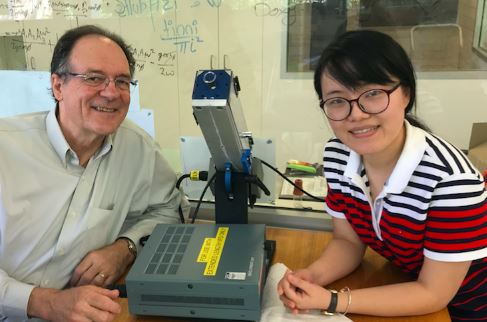
An improved clean and green means of coating materials for efficient wastewater treatment processes is now possible thanks to the Vortex Fluidic Device.
The adaptability and wider clean chemistry applications of the extraordinary Vortex Fluidic Device (VFD) – invented by Flinders University's Professor Colin Raston - continues to achieve unexpected innovations.
This time the VFD has been used to demonstrate potential for water treatment with real time detection of impurities.
Since 2013, Professor Raston has been working with his team to explore the possibilities of the VFD, which is capable of controlling chemical reactivity, materials processing and probing the structure of self-organised systems, enabling rapid and now predictable modifications.
The VFD has shown its capability in the synthesis of esters, amides, ureas, imines, alpha-amino phosphates, beta-Keto esters, modified amino acids and the local anaesthetic, lidocaine. It is opening new frontiers of research.
Now, Dr Xuan Luo, from Flinders University's College of Science and Engineering, has led research into using the VFD to prepare composite materials and coat them for dye degradation/wastewater treatment.
"The VFD enables coating the material as one layer but also as segregated bands for multi-step reactions," says Dr Luo. "This set-up applies to multiple synthetic dyes and we saw dramatic increase in degradation efficiency while using the VFD."
Current research focuses on more effective and robust coatings to be prepared on a flexible membrane which could be rolled up and inserted into VFD then removed, rinsed and re-stored post-reaction.
"The applications do not only apply to water treatment, but also has huge potential in health-related areas such as diagnostics," says Dr Luo.
The research – Magnetite Nanoparticle/Copper Phosphate Nanoflower Composites for Fenton-like Organic Dye Degradation (2022) by Xuan Luo, Wanling Cai, Kasturi Vimalanathan, Aghil Igder, Zoe Gardner, Spencer Petticrew, Shan He, Clarence Chuah, Youhong Tang, Peng Su, Wei Zhang and Colin Raston – has been published by ACS Applied Nano Materials. DOI: 10.1021/acsanm.2c00037

The tested technique provided a fast and sustainable way to use three different VFD applications for material fabrication, reactor coating, and material "banding".
The materials were magnetically held against the surface of the VFD's rapidly rotating tube, enhancing catalytic activity in degrading four different organic dyes under real-time monitoring, with at least a fivefold increase in the degradation efficiency compared to batch processing.
To further improve the platform performance, the VFD tube reactor was chemically modified, incorporating a thin layer of silica-activated carbon xerogel coating which behaves synergistically with the composite nanoflowers. This coated tube is highly stable and reusable, and dramatically increases degradation efficiency by about 30-fold compared to using batch processing.
Integrating an ultraviolet-visible spectroscopy-based probe allows real-time monitoring of the reaction and also provides a direct tool to evaluate the coating layer post reaction.
This study provides a rational design of hybrid materials and the use of a modified VFD tube reactor toward efficient degradation of organic dyes in real time.
Fast and green material fabrication, coupled with significantly improved processing efficiency, is effective for water treatment - from fundamental research to applications industry, adds Professor Colin Raston.
"The research will lead to new forms of detection, which will be important in other applications, such as in membrane and coating technologies," he says.






